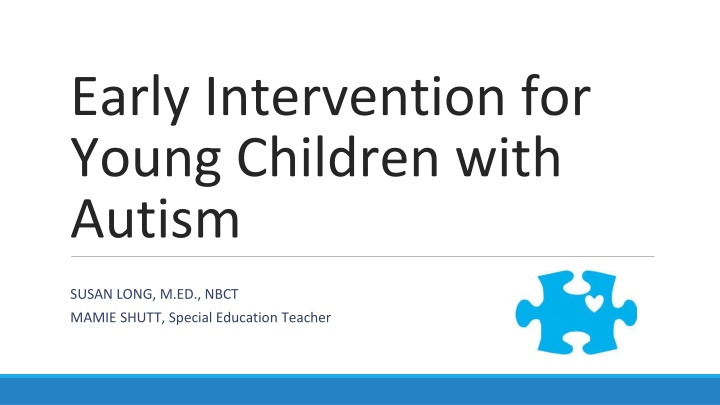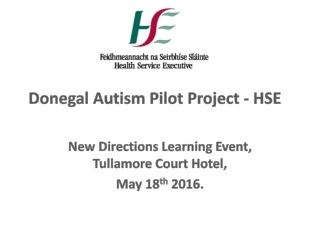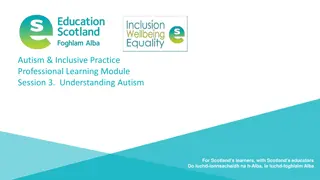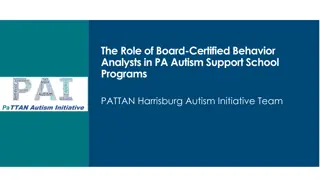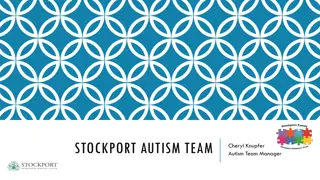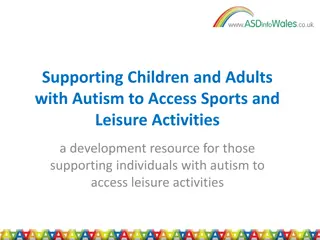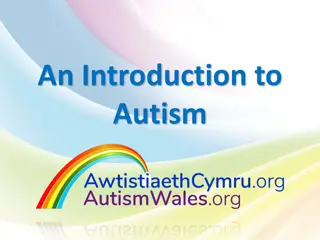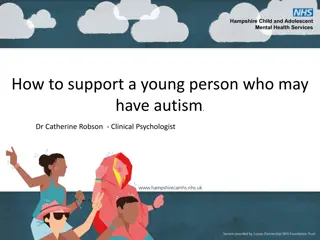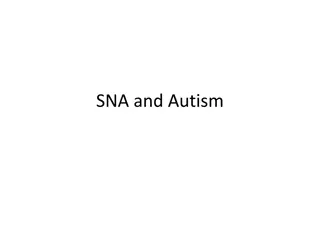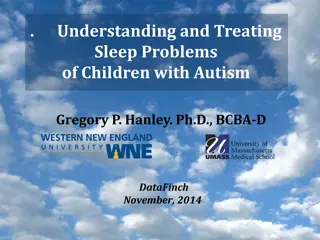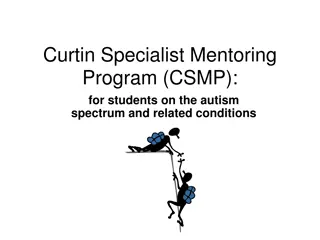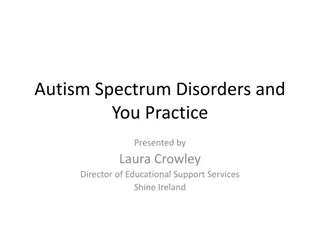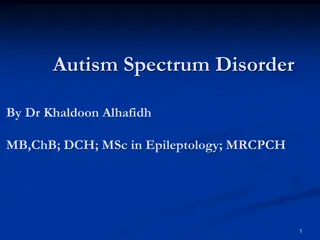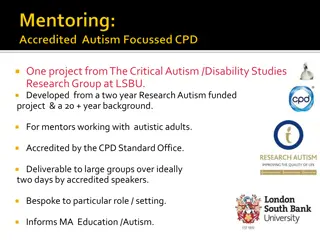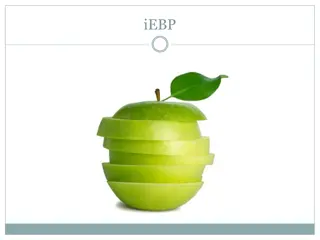Early Intervention for Young Children with Autism
Early intervention is crucial for children with autism to support their development. Brain research shows how experiences influence brain architecture, emphasizing the importance of interventions during early childhood. Stress can impact brain development, with positive stress being beneficial and tolerable stress requiring supportive relationships. Understanding these aspects can guide strategies for parents and caregivers to enhance a child's growth and well-being.
Download Presentation

Please find below an Image/Link to download the presentation.
The content on the website is provided AS IS for your information and personal use only. It may not be sold, licensed, or shared on other websites without obtaining consent from the author.If you encounter any issues during the download, it is possible that the publisher has removed the file from their server.
You are allowed to download the files provided on this website for personal or commercial use, subject to the condition that they are used lawfully. All files are the property of their respective owners.
The content on the website is provided AS IS for your information and personal use only. It may not be sold, licensed, or shared on other websites without obtaining consent from the author.
E N D
Presentation Transcript
Early Intervention for Young Children with Autism SUSAN LONG, M.ED., NBCT MAMIE SHUTT, Special Education Teacher
Goals 1. Get to know one another. What brought you here today? 1. Learn about the importance of early intervention. 1. Discuss intervention strategies for parents and caregivers.
Why Does Early Intervention Matter?
Brain Development Research Early experiences determine whether a child s developing brain architecture provides a strong or weak foundation for all future learning, behavior, and health. Brain development is influenced by genetics, environment, and experience Genes determine when circuits are formed Experience shapes how that formation unfolds A warm, individualized, and stimulating environment is best
Brain Development Research Skills are mastered at different ages, therefore, opportunities for intervention are present in early childhood Birth to 3: rapid cognitive, linguistic, social, emotional, and motor development 15-18 months into preschool: major growth in vocabulary 3-5 years: increasingly complex social behaviors, emotions, problem solving, and pre-literacy skills 4-5 years: basic grammar, recognize and identify simple emotions in self and others, understand others point of view, develop conscience (shame/guilt), begin to negotiate to achieve a common goal, ability to sit quietly with a group, pay attention for brief periods
Brain Development Research: Stress and the Brain Stress can be growth-promoting OR toxic dependent on intensity and duration: 1. Positive stress produces short-lived physiological responses, such as brief increases in heart rate and blood pressure examples: meeting new people, dealing with frustration
Brain Development Research Stress and the Brain 2. Tolerable stress can trigger physiological responses large enough to disrupt brain architecture, but can be relieved by supportive relationships examples: death of a loved one, divorce, natural disaster, act of terrorism
Brain Development Research: Stress and the Brain 3. Toxic stress most threatening level of stress occurs without the protection of adult support can lead to cardiovascular disease, hypertension, obesity, diabetes, stroke, mental illness such as depression, anxiety, and substance abuse examples: recurrent child abuse or neglect, severe maternal depression, parental substance abuse, family violence
Brain Development Research Five Numbers to Remember about Early Childhood Development 1. Getting things right the first time is easier and more effective than trying to fix them later. 2. Early childhood matters because experiences early in life can have a lasting impact on later learning, behavior, and health. 3. Highly specialized interventions are needed as early as possible for children experiencing toxic stress. 4. Early life experiences actually get under the skin and into the body, with lifelong effects on adult physical and mental health. 5. All of society benefits from investments in early childhood programs.
Intervention Strategies For Parents and Caregivers
Establish Daily Routines Daily routines impact a child s emotional, cognitive, and social development. They provide a framework for a young child to learn because they are functional and predictable. Routines provide a base for intervention strategies to take place.
Establish Daily Routines: Caregiving Each routine is made up of smaller steps, which can be used to target developmental skills. For example:
Establish Daily Routines: Play Play is an important way to develop language, cognition, and social competence as well as self-regulation. Play supports the abilities that underlie academic learning and thus to promote school success. Attending to child interests and child-initiated interactions is important. Infants and young children actively engage in activities and events and use materials that hold interest for them. Children engage in various kinds of play, such as physical play, object play, pretend or dramatic play, constructive play, and games with rules.
Establish Daily Routines: Transitions We know that children with ASD have difficulty with transitions from one activity to another. For very young children, this is often due to poor receptive language skills. We also know that children with ASD are often visual learners. Using transition objects is a way to provide visual information to support and build receptive language skills. Transition objects are pair-associated, concrete objects given with a verbal prompt help children understand upcoming transitions.
Building Daily Routines: Transitions Examples of Transition Objects & Implementation: give the child a bowl, say eat give the child a blanket, say rest give the child a ball, say play Remember to use transition objects consistently. The same object should always represent the same routine.
Target Social Communication Social communication is a two-way process, where both partner s actions impact the other. Parent-child relationships provide the perfect context to teach social communication. Working on social communication between parent and child at an early age helps strengthen relationships.
Target Social Communication: Looking at Faces Looking at faces is an early developing skill critical to social communication. Young children with ASD spend more time looking at objects rather than looking at faces. Teaching a child to look at parent s or caregiver s face is a logical starting point for intervention.
Target Social Communication: Reciprocal Exchange Reciprocity refers to back-and-forth actions or turn-taking. Parents can promote turn-taking by playing simple repetitive games that are fun for the child.
Target Social Communication: Joint Attention Joint attention is a form of showing or nonverbal commenting to share social interest in an object with another person. Helping the child respond to the parent s lead is a good starting point. Parents can help their children initiate joint attention by watching and waiting rather than by always being the one to do the showing.
Target Social Communication: Joint Attention
Target Social Communication: Verbal Language Joint attention leads to the use of verbal language. Parents can use more verbal language into their play. Verbally based social communication is promoted by interacting around shared interests.
Use Naturalistic Intervention Strategies Naturalistic Intervention (NI) is an Evidence-Based Practice. Research indicates it is effective for children from birth to age 11. The focus of NI is integrating learning opportunities into existing routines.
Use Naturalistic Intervention Strategies Strategy Examples Use Strategy Use novel materials and change things up in familiar routines and activities. To set up the environment and to engage a learner if he/she does not seem interested in playing with you or seems to be bored during an activity Add new toys to a play area in the classroom Move preferred items/toys into a different location Put something silly (e.g. a stuffed animal or toy figure) somewhere it should not be (e.g. in a toy sink)
Use Naturalistic Intervention Strategies Strategy Examples Use Strategy Respond to & comment on what the learner is saying/doing. To help the learner engage with you while playing Narrate what the learner is doing (e.g. Oh, I see you are building with blocks! ) Ask the learner questions (e.g. What should we do next? Tell me about what you are doing. ) When the learner vocalizes, respond with words, even if the vocalization is not directed at you
Use Naturalistic Intervention Strategies Strategy Examples Use Strategy Imitate what the learner is saying/doing. Make the same sounds/words right after the learner does, and wait to see if the learner looks towards you and engages Do the same actions as the learner and encourage the learner to look toward you and engage To draw the learner s attention to you
Use Naturalistic Intervention Strategies Strategy Examples Use Strategy Expand on what the learner is saying/doing. To keep the learner engaged following the start of an activity Bring toy figures into play with cars or blocks Add another step onto a play routine (e.g. if the learner is pretending to feed a baby, encourage the learner to feed you as well)
Use Naturalistic Intervention Strategies Strategy Examples Use Strategy Give the learner choices. To encourage learner engagement and communication Offer choices to the learner with play items and food
Use Naturalistic Intervention Strategies Strategy Examples Use Strategy To help the learner remain engaged and interested in the activity Follow the learner s lead. Get down on the same level as the learner and play with what the learner is playing with
Use Naturalistic Intervention Strategies Strategy Examples Use Strategy Exaggerate your sounds and movements. Be loud and silly while playing with/working with the learner To draw the learner s attention to you
References Amsbary, J., & AFIRM Team. (2017). Naturalistic intervention. Chapel Hill, NC: National Professional Development Center on Autism Spectrum Disorder, FPG Child Development Center, University of North Carolina. Retrieved from http://afirm.fpg.unc.edu/Naturalistic-intervention Center on the Developing Child (2009). Five Numbers to Remember About Early Childhood Development (Brief). Retrieved from www.developingchild.harvard.edu. Center on the Developing Child at Harvard University (2007). A Science-Based Framework for Early Childhood Policy: Using Evidence to Improve Outcomes in Learning, Behavior, and Health for Vulnerable Children. http://www.developingchild.harvard.edu Developmentally Appropriate Practice in Early Childhood Programs Serving Children from Birth through Age 8. (2009). NAEYC. Retrieved from https://www.naeyc.org/resources/topics/dap/position-statement
References The Importance of Early Intervention for Infants and Toddlers with Disabilities and their Families(Publication). (2011, July). Jennings, D., Hanline, M. F., & Woods, J. (2012). Using Routines-Based Interventions in Early Childhood Special Education. Dimensions of Early Childhood,40(2), 13-22. Odom, S. L., & Wolery, M. (2003). A Unified Theory of Practice in Early Intervention/Early Childhood Special Education. The Journal of Special Education,37(3), 164-173. doi:10.1177/00224669030370030601 Schertz, H. H., Horn, K., Lee, M., & Mitchell, S. (2016). Supporting Parents to Help Toddlers With Autism Risk Make Social Connections. Young Exceptional Children,20(1), 16-29. doi:10.1177/1096250615576808
